Managing Victoria’s Public Housing
Overview
Housing is important for all Victorians. Without access to affordable and secure housing, people are exposed to increased risk of homelessness, mental illness and an inability to meet living costs.
Public housing is an important means of assisting those in greatest need of affordable and secure housing. It includes 64 663 dwellings owned and/or managed by government, and is used to provide long-term subsidised rental accommodation to low-income, disadvantaged households.
In this audit, we assessed whether the development of the whole-of-Victorian Government housing strategy, as it relates to public housing, was supported by sound advice. We also assessed whether the Department of Health and Human Services (DHHS) is managing its public housing portfolio effectively. In addressing this objective, we followed up on recommendations from our last public housing performance audit in 2012, Access to Public Housing.
We make four recommendations for DHHS, the Department of Premier and Cabinet and the Department of Treasury and Finance. We make two further recommendations for DHHS.
Managing Victoria’s Public Housing: Message
Ordered to be published
VICTORIAN GOVERNMENT PRINTER June 2017
PP No 254, Session 2014–17
President
Legislative Council
Parliament House
Melbourne
Speaker
Legislative Assembly
Parliament House
Melbourne
Dear Presiding Officers
Under the provisions of section 16AB of the Audit Act 1994, I transmit my report Managing Victoria's Public Housing.
Yours faithfully

Andrew Greaves
Auditor-General
22 June 2017
Audit overview
Access to affordable and secure housing reduces the risk of homelessness and improves people's capacity to meet living costs. It can also be beneficial in addressing issues such as mental illness.
Government and non-government not-for-profit organisations provide social housing to people who are unable to access suitable accommodation in the private market.
Social housing is an umbrella term for two different types of housing:
- Public housing refers to 64 663 dwellings (as at 30 June 2016) owned and/or managed by government, and used to provide long-term subsidised rental accommodation to low-income, disadvantaged households.
- Community housing refers to around 19 000 dwellings owned and/or managed by not‑for-profit organisations regulated by government. Community housing also includes 1 525 properties for low-income Aboriginal and Torres Strait Islander people in Victoria.
The Housing Act 1983 (the Act) sets out the legislative framework for public housing. The Act establishes the roles and responsibilities of the Director of Housing, who sits within the Department of Health and Human Services (DHHS).
The Director of Housing is the landlord of Victoria's public housing and has powers to purchase, develop, lease and sell property. More broadly, DHHS' public housing role covers tenant applications, allocation of property to tenants, asset management, procurement and tenancy management.
Work began in September 2015 on a whole-of-government strategy to address housing affordability challenges, including the undersupply of social housing. The strategy, Homes for Victorians, was released in March 2017. Its development was supported by DHHS, the Department of Premier and Cabinet (DPC) and the Department of Treasury and Finance (DTF).
One of the five initiatives in Homes for Victorians is to increase and renew social housing stock. This includes a $1 billion social housing growth fund to deliver more social housing, and a four-year $201 million program to redevelop public housing estates.
In this audit, we assessed whether the development of the whole-of-Victorian Government housing strategy, as it relates to public housing, was supported by sound advice.
We also assessed whether DHHS is managing its public housing portfolio effectively. In addressing this objective, we followed up on recommendations from our last public housing performance audit in 2012, Access to Public Housing. These recommendations are listed in Figure A.
Figure A
Recommendations from VAGO's 2012 audit
|
The [former] Department of Human Services should: 1. develop and apply options to overcome the unsustainable operating model 2. assess its operational efficiency and role in public housing 3. develop a long-term plan for public housing with clear objectives 4. develop a comprehensive asset management strategy and vigorously monitor performance 5. at the regional level, capture local knowledge and communicate investment criteria 6. update and strengthen property condition data across the portfolio 7. apply relevant data and medium- and longer-term forecasts to asset management strategies. |
Source: VAGO.
Conclusion
The key public housing challenges we identified in 2012—financial sustainability that is managed using short-term approaches, ageing stock and growing demand that cannot be fully met within existing resourcing levels—have persisted.
Although DHHS has responded to each of our recommendations from 2012, it is still not managing its public housing effectively. The absence of a clear long-term direction for public housing for much of the period since the previous audit has not helped. An asset management framework that is disjointed, poorly communicated and lacking in a comprehensive understanding of asset performance is also at the root of this failure.
It is encouraging to see recent and ongoing work at both the departmental and whole-of-government level to address these issues. In particular, the March 2017 housing affordability strategy Homes for Victorians reflects an increased focus on growing social housing supply and driving a more integrated service delivery model for the community housing sector.
The measures in Homes for Victorians related to public housing are underpinned by extensive advice that successfully identified and considered the key challenges facing public housing. However, gaps in this advice mean it is unclear whether funded initiatives will translate into meaningful social housing growth and address the significant gap between supply and demand.
Further work is also needed to clarify a long-term strategic direction and to understand the likely impacts of plans to make the community housing sector allocate more housing to critical-need applicants who have traditionally been supported through the public housing system.
Findings
DHHS has responded to the seven recommendations from our 2012 audit in a number of ways, which include but are not limited to:
- developing the March 2014 policy New Directions for Social Housing: A Framework for a Strong and Sustainable Future—however, this framework was not supported following the change in government in late 2014
- contributing to the development of Homes for Victorians in collaboration with DPC and DTF
- finalising its 2014 asset strategy and commencing work in 2016 to update it
- commissioning an audit of the condition of its properties in 2013–14, which assessed approximately 96 per cent of public housing stock
- commissioning various reviews of its operational performance relating to public housing.
Despite this work, we found that action on each recommendation remains incomplete.
Addressing challenges to the public housing operating model —2012 recommendations 1, 2 and 3
The key public housing challenges highlighted in the 2012 audit remain relevant today:
- Financial sustainability—our 2012 audit highlighted significant risks regarding financial sustainability. Public housing rental operations ran at a deficit between 2012–13 and 2015–16, with a small surplus forecast for 2016–17. While the Director of Housing's cash position and net operating cash flow surpluses indicate financial sustainability, these results mask the use of unsustainable strategies such as postponing renewal and acquisition programs.
- Lack of long-term direction—public housing has lacked an overarching long‑term direction for much of the period since the last audit. The March 2014 release of a new framework, New Directions for Social Housing: A Framework for a Strong and Sustainable Future, set a range of directions for social housing reform, but did not set any overarching targets in terms of growth and sustainability. When the government changed in late 2014, it did not support the framework. The overarching long-term direction for public housing remains unclear following the release of Homes for Victorians in March 2017, due to the strategy's broader focus on housing affordability issues and no specific targets set for public housing growth or sustainability.
- Ageing stock—the average age of Victoria's public housing stock is 35 years. In total, 60 per cent of public housing stock is now over 30 years old, compared to 42 per cent at the time of the 2012 audit. While it is clear that Victoria's public housing stock is ageing, DHHS lacks data to reliably assess the condition of its stock, and consequently whether it is deteriorating at a rate faster than it is ageing.
- Unmet demand—the public housing waiting list has not grown since the 2012 audit. However, the waiting list does not reflect true demand for social and affordable housing, in part because waiting lists cannot account for unexpressed demand from people who qualify for public housing but have not applied. In December 2016, Victoria's 30-Year Infrastructure Strategy estimated that between 75 000 and 100 000 vulnerable, low-income households do not have access to affordable housing. Victoria's public housing stock is not designed, or well placed, to meet this demand. The total stock of public housing decreased by 581 dwellings between 2006 and 2016, while the number of community housing dwellings increased by 9 593 over the same period. With public housing supply not meeting demand, DHHS has focused its allocations on people in greatest need. Despite this focus, the average waiting time to be allocated public housing has remained relatively stable since 2011–12 across all priority groups on the waiting list.
- Misalignment of stock and demand—Victoria's public housing portfolio is not configured to meet the growing demand for one- and two-bedroom dwellings, which accounts for around 80 per cent of public housing applicants. Currently there are more three-bedroom dwellings than any other configuration. Overcoming this challenge in the short-term is very difficult, due to the high cost and disruptive nature of reconfiguring public housing stock.
There is significant work underway to address these challenges including:
- the implementation of Homes for Victorians, which is addressing public housing challenges through a broader set of social housing measures
- the implementation of a new Victorian Housing Register that will combine the public housing waiting list with various community housing waiting lists—this register is expected to provide a clearer picture of social housing demand and a more streamlined application process
- several department-level initiatives that aim to better understand and address sustainability issues in public housing.
Development of social housing measures in Homes for Victorians
Homes for Victorians is the most significant of these initiatives. The development of the strategy was supported by an extensive range of work at a whole-of-government level, including detailed consideration of existing social housing deficiencies and risks, social housing practices in other jurisdictions, and potential measures to grow and sustain social housing. The strategy's measures that relate directly to social housing are summarised in Appendix B.
However, neither the strategy nor the advice that supported its development have sufficiently measured the likely impact of funded initiatives on current and projected demand for social housing.
A key focus of Homes for Victorians is growing the community housing sector. This approach could ease pressure on the public housing system, and includes compelling the community housing sector to allocate 75 per cent of its housing to critical-need applicants with lower incomes. However, this could also have significant financial impacts on their financial viability. Currently, DHHS does not clearly understand these impacts and they require further investigation. The potential impacts need to be carefully balanced against the needs of the most disadvantaged Victorians.
Two other recent initiatives have supported the strategy's social housing measures:
- DHHS, DTF and DPC's formation of an interdepartmental housing project steering committee, which has already begun planning to deliver the measures
- the Family Violence Housing Assistance Implementation Taskforce, which has a central role in overseeing initiatives funded under the $152 million Family Violence Housing Blitz.
Developing an asset strategy —2012 recommendations 4 and 7
DTF's Asset Management Accountability Framework—which in 2016 replaced the policy statement Sustaining Our Assets—highlights the importance of having an asset strategy to guide and optimise asset management decisions at each stage of the life cycle—planning, acquisition, operation and disposal.
DHHS has continued to operate without an up-to-date asset strategy for much of the time since the 2012 audit. It drafted an interim asset strategy for use in 2012–13 and 2013–14, although this strategy was not finalised before DHHS developed its five-year asset strategy in 2014, which is still in use. Much of this asset strategy's content became outdated following the change in government in late 2014 but it has not been revised since then.
The 2014 asset strategy and supporting implementation plans do not:
- reflect a systematic or transparent life cycle approach to managing assets—although the recent development of asset intent guidelines is a positive development
- establish a useful governance and performance monitoring regime for assets
- reflect a systematic or comprehensive understanding of service demand over the medium to long term.
DHHS is now updating its asset strategy, with work to date focused on investigating social housing supply and demand across Victoria. It is important that the next asset strategy address the above weaknesses.
Strengthening property condition data —2012 recommendation 6
DHHS uses a range of inputs to inform its decisions about asset planning for public housing. Comprehensive and accurate data about property condition is critical for ensuring that these decisions are well informed.
Issues with DHHS' public housing property condition assessments undermine its capacity to manage its portfolio. These issues include:
- a lack of evidence about the reliability of property condition assessments (PCA) performed between January 2013 and October 2014
- an inability throughout 2016 to perform PCAs to the contracted standard on an ongoing basis—PCAs during this period have not met service levels for timeliness, accuracy and quality assurance.
DHHS is implementing new arrangements for its PCAs.
Capturing local knowledge —2012 recommendation 5
DHHS has continued to use a centralised approach for asset planning since our 2012 audit, and the issues identified previously regarding inconsistent regional input to asset planning remain. In particular:
- there had been a lack of both communication with regions and feedback sought from regions about asset management programs, with particular concern about redevelopments, acquisitions and handovers of new developments from central office
- decision-making arrangements for regional requests were unclear, particularly for acquisitions and disposals.
DHHS has demonstrated recent efforts to improve how it communicates with and seeks input from regional staff about asset planning. DHHS is now working to improve regional engagement through several key initiatives, including development of regional asset plans, an online reporting tool, and regional workshops to inform asset upgrade decisions.
Recommendations
We recommend that the Department of Health and Human Services, the Department of Treasury and Finance and the Department of Premier and Cabinet—through the Interdepartmental Housing Project Steering Committee:
1. agree on a long-term strategic direction for public housing that sets targets for growth, sustainability and meeting demand (see Sections 2.2.1 and 3.2)
2. monitor, evaluate and report on the delivery of measures related to public housing in Homes for Victorians, including their impacts on social housing growth, sustainability and demand (see Section 3.2.3)
3. assess the financial and operational impacts of changes to the community housing sector's role arising from Homes for Victorians, including new housing allocation requirements (see Sections 3.2.2 and 3.3.2)
4. identify and implement strategies to improve the financial sustainability of the public housing rental operating model over the long term (see Section 2.2.2).
We recommend that the Department of Health and Human Services:
5. develop and implement an asset strategy for public housing that:
- reflects a comprehensive understanding of service supply and demand over the short, medium and long term
- establishes outcome-focused performance standards for asset management that adhere to the benefit-mapping principles contained in Department of Treasury and Finance's Investment Management Standard
- establishes a holistic and transparent life cycle approach to asset planning decisions that captures regional input
- establishes governance arrangements that clearly communicate roles and responsibilities and provide for sustained oversight of asset management performance
- is reviewed and updated so that it remains current
6. through its asset strategy, develop and implement plans to:
- overcome identified shortcomings with property condition assessments to support evidence-based asset planning decisions
- optimally balance expenditure on all maintenance types
Responses to recommendations
We have consulted with the Department of Health and Human Services, the Department of Premier and Cabinet and the Department of Treasury and Finance, and we considered their views when reaching our audit conclusions. As required by section 16(3) of the Audit Act 1994, we gave a draft copy of this report to those agencies and asked for their submissions or comments.
The following is a summary of those responses. The full responses are included in Appendix A.
The Department of Health and Human Services, the Department of Premier and Cabinet and the Department of Treasury and Finance responded, accepting the recommendations, and providing a detailed action plan on how they will address them.
1 Audit context
Housing is important for all Victorians. Without access to affordable and secure housing, people face an increased risk of homelessness, mental illness and inability to meet living costs. Social housing is an important means of helping those in greatest need. Government, non-government and not-for-profit organisations provide social housing to people who are unable to access suitable accommodation in the private market. Figure 1A shows the types of social housing provided in Victoria.
Figure 1A
Social housing options

Note: Community housing organisations provide crisis housing and transitional housing.
Source: VAGO.
Public housing is owned and/or managed by government and provides long-term subsidised rental accommodation across 64 663 dwellings (as at 30 June 2016). Some of the most disadvantaged Victorians live in public housing, including those with a disability or mental illness, and those who have a history of homelessness.
Community housing comprises around 19 000 dwellings, and is owned and/or managed by registered housing agencies. These organisations provide long-term affordable rental housing, as well as short-term crisis and transitional housing for people experiencing homelessness. Community housing also comprises 1 525 properties that are provided to low-income Aboriginal and Torres Strait Islander people in Victoria—these properties are managed by Aboriginal Housing Victoria, a not-for-profit housing organisation.
1.1 Public housing in Victoria
1.1.1 Legislative framework
The legislative framework for public housing is set out in the Housing Act 1983 (the Act). The Act's key objective is to ensure that every person in Victoria has adequate and appropriate housing that is within his or her means. Other relevant objectives include:
- expand and develop the public sector's role in housing provision
- promote cost-effective housing provision
- promote public and private housing integration
- provide a variety of public housing types in various locations
- promote security and variety of tenure
- seek tenant and community participation in public housing management
- promote stakeholder consultation on housing policy issues
- coordinate provision of public housing-related community services and amenities.
The Act establishes the roles and responsibilities of the Director of Housing as a body corporate who sits within the Department of Health and Human Services (DHHS). At 30 June 2016, the Director of Housing was the landlord of Victoria's 64 663 public housing dwellings and has powers to purchase, own, develop, lease and sell property.
The Director of Housing's public housing stock is valued at approximately $21 billion.
1.1.2 Department roles
DHHS develops and delivers policies, programs and services that support the health and wellbeing of Victorians. Its public housing role covers tenant applications, allocations and tenancy management, as well as maintenance and procurement of public housing assets.
The Department of Treasury and Finance (DTF) provides economic, financial and resource management advice to help government deliver its policies. Its specific roles related to public housing include:
- advising government on issues with asset management and infrastructure delivery
- providing shareholder advisory services and oversight of government business enterprises and large non-financial corporations, including the Director of Housing
- assessing budget bids that fall under the Director of Housing.
1.1.3 Policy
In March 2014, the former Victorian Government released its framework for social housing, New Directions for Social Housing: A Framework for a Strong and Sustainable Future. This framework was intended to respond to long-standing social housing issues including the deterioration of public housing stock and the lack of an overarching strategy. It included 19 actions focused on delivering better communities, better opportunities and better assets. However, when the government changed in late 2014, the new government did not support the framework.
In September 2015, a Parliamentary committee was formed to:
- provide direction regarding the Victorian Government's housing priorities and its response to housing challenges
- coordinate the development of policies that influence housing.
In December 2015, government endorsed the development of a housing strategy to address housing affordability challenges, including the undersupply of social housing. This is the first time that housing affordability is being addressed from an integrated, whole-of-Victorian Government perspective.
An interdepartmental committee was established to support the strategy's development. This committee is led by DPC and includes representatives from DHHS, DTF, the Department of Environment, Land, Water and Planning, and Consumer Affairs Victoria.
Victoria's housing affordability strategy, Homes for Victorians, was released in March 2017. Figure 1B lists all the measures included in Homes for Victorians. Measures listed in bold relate directly to social housing provision—see Appendix B for further detail on these specific measures.
Figure 1B
Summary of housing affordability measures in Homes for Victorians
|
Key policy direction |
Measures |
||
|---|---|---|---|
|
1 |
Supporting people to buy their own home |
1.1 |
Abolishing stamp duty for first home purchases under $600 000 |
|
1.2 |
Doubling the First Home Owner Grant in regional areas |
||
|
1.3 |
Shared equity opportunities for first home buyers |
||
|
1.4 |
Housing for first home buyers in key precincts |
||
|
1.5 |
Rebalancing the market between investors and home buyers |
||
|
1.6 |
Reforms for a fairer real estate market |
||
|
2 |
Increasing the supply of housing through faster planning |
2.1 |
Planning for Victoria's growth |
|
2.2 |
Increasing development opportunities in the inner and middle suburbs |
||
|
2.3 |
Land supply in Melbourne's growth corridors—100 000 extra lots |
||
|
2.4 |
Inclusionary housing to increase the supply of social and affordable housing |
||
|
2.5 |
Speeding up local government planning decisions |
||
|
2.6 |
Smarter planning for permits |
||
|
3 |
Promoting stability and affordability for renters |
3.1 |
Reform of the Residential Tenancies Act 1997 |
|
3.2 |
Supporting households to sustain long-term housing |
||
|
3.3 |
Making long-term leasing a real option for Victorians |
||
|
3.4 |
Residential parks |
||
|
3.5 |
Better Apartment guidelines |
||
|
4 |
Increasing and renewing social housing stock |
4.1 |
Victorian Social Housing Growth Fund |
|
4.2 |
Building more social housing and redeveloping ageing supply |
||
|
4.3 |
Financial backing for the community housing sector |
||
|
4.4 |
Increasing capacity of the community housing sector |
||
|
4.5 |
The Victorian Housing Register |
||
|
5 |
Improving housing services for Victorians in need |
5.1 |
Moving homeless Victorians to stable housing |
|
5.2 |
Towards Home—rough sleeping package |
||
|
5.3 |
Family violence housing measures |
||
|
5.4 |
Rooming houses |
||
|
5.5 |
The Victorian Property Fund |
||
Note: Strategy measures in bold relate directly to the provision of social housing.
Source: VAGO, based on Homes for Victorians, 2017.
1.1.4 Supporting family violence and homelessness initiatives
The report on the Royal Commission into Family Violence, published March 2016, identified housing assistance as a particular challenge for victims of family violence. Following this report, the government announced a number of housing-related investments throughout 2016. These investments also form part of Homes for Victorians and include:
- the $152 million Family Violence Housing Blitz in April 2016 to increase options for crisis and emergency accommodation, help victims remain at home, and redevelop family violence refuges—this includes $50 million to provide 130 new social housing properties and secure head leases for up to 100 dwellings
- $10 million in August 2016 to upgrade Victorian rooming houses
- $120 million in September 2016 to redevelop and grow social housing, covering both short- and long-term accommodation—this includes $30 million to begin redevelopment of public housing in Flemington and $60 million to increase social housing on vacant or under-used government land
- the $109 million Homelessness Support Package in November 2016 to provide targeted support for people at risk of or experiencing homelessness
- $218 million in social housing and private rental assistance through the 10-year plan for family violence, Ending Family Violence: Victoria's Plan for Change, which commits to redeveloping over 2 800 public housing properties and building over 1 000 new social housing properties.
In May 2016, the government established a Family Violence Housing Assistance Implementation Taskforce, comprising experts on private and social housing, homelessness and family violence. The taskforce advises the Minister for Housing, Disability and Ageing and the government on housing solutions for people experiencing family violence, unblocking housing options for people in crisis and driving longer-term social housing growth. In particular, the taskforce has a role in overseeing initiatives funded under the $152 million Family Violence Housing Blitz.
1.1.5 Types and distribution of social housing stock owned by the Director of Housing
Figure 1C shows the distribution of the Director of Housing's social housing stock by type and geographic division.
Figure 1C
Distribution of social housing stock owned by the Director of Housing, by type and division, at 30 June 2016
|
Type |
Division |
Total |
|||
|---|---|---|---|---|---|
|
East |
North |
South |
West |
||
|
House |
4 774 |
6 184 |
6 377 |
7 407 |
24 742 |
|
High-rise flat |
– |
3 019 |
1 690 |
2 860 |
7 569 |
|
Low-rise flat |
657 |
2 176 |
2 362 |
2 135 |
7 330 |
|
Medium-density—attached |
5 055 |
7 723 |
7 687 |
7 596 |
28 061 |
|
Medium-density—detached |
445 |
749 |
573 |
695 |
2 462 |
|
Movable unit |
292 |
335 |
372 |
292 |
1 291 |
|
Multiple Unit Facility Unit |
209 |
145 |
743 |
232 |
1 329 |
|
Other |
105 |
162 |
236 |
343 |
846 |
|
Total |
11 537 |
20 493 |
20 040 |
21 560 |
73 630 |
Note: Amounts include community and Aboriginal housing stock owned by the Director of Housing but managed by the community housing sector.
Source: VAGO, based on DHHS data.
1.2 Asset Management Accountability Framework
The Department of Treasury and Finance's Asset Management Accountability Framework (AMAF) was introduced in June 2016 and details mandatory asset management requirements and general guidance for public sector agencies with asset management responsibilities. It replaces the previous asset management framework, Sustaining Our Assets.
The AMAF—and the previous policies it replaced—requires a whole-of-life-cycle approach to asset management across four stages:
- planning—determining asset requirements based on service delivery needs and the asset base's ability to meet those needs
- acquisition—procuring assets to meet an identified service need, including assessing procurement options
- operation and maintenance—using and managing assets to deliver services, including maintenance of assets
- disposal—treating assets that have reached the end of their useful life, are considered surplus, or are underperforming.
The AMAF's mandatory requirements for public sector agencies include, but are not limited to, developing asset management strategies, governance frameworks and performance standards. From 2017–18 onwards, public sector agencies must attest to their compliance with the mandatory requirements of the AMAF in their annual report and self-assess their asset management maturity every three years.
1.3 Why this audit is important
This is our fifth performance audit focused on social housing over the past 20 years. Most recently, our 2012 audit Access to Public Housing examined how effectively the former Department of Human Services (DHS) planned for and maintained public housing assets to support current and future access for eligible tenants. We concluded that:
- the operating model for public housing is unsustainable, with costs increasingly exceeding revenue
- DHS had not set an overarching direction or long-term objectives for public housing
- there was no asset management strategy in place and past strategies had fallen short of asset management guidelines
- DHS lacked basic information including accurate data about property condition.
These issues present significant risks for government at a time when Victoria is experiencing growing homelessness and declining housing affordability. The 2011 census reported that more than 22 780 Victorians are homeless—a 31 per cent increase from 2006. In 2015–16 homelessness services assisted more than 113 000 Victorians.
1.4 What this audit examined and how
The objective of this audit was to determine whether the development of the whole‑of‑Victorian Government housing strategy, as it relates to public housing, is supported by sound advice, and whether DHHS is managing public housing effectively.
To address this objective, we assessed whether:
- advice about public housing provided to government in the development of a whole-of-Victorian Government housing strategy was based on sound assumptions and rigorous analysis of information
- DHHS has identified effective strategies and programs to ensure the sustainability of Victoria's public housing operating model
- DHHS has a sound framework in place to support effective management of public housing assets.
We also followed up on recommendations from our last public housing audit in 2012.
The audited agencies included:
- DHHS, as the agency responsible for public housing
- DPC and DTF, both of which have central roles in developing the whole-of-Victorian Government housing strategy.
This audit examined the period since our last public housing performance audit in 2012.
We conducted the audit in accordance with section 15 of the Audit Act 1994 and the Australian Auditing and Assurance Standards. The cost of this audit was $690 000.
1.5 Report structure
The remainder of the report is structured as follows:
- Part 2 examines key challenges facing Victoria's public housing and progress against our 2012 recommendations
- Part 3 examines ongoing work to improve public housing
- Part 4 examines DHHS' actions to address our 2012 recommendations related to asset management.
2 Progress and challenges
This Part of the report examines the key challenges to public housing in Victoria leading up to the March 2017 release of the housing affordability strategy Homes for Victorians. In doing this, we have followed up on related recommendations from our 2012 audit Access to Public Housing.
Figure 2A shows the three recommendations in our 2012 audit that focused on addressing system-level challenges for public housing.
Figure 2A
Recommendations from our 2012 audit relating to system-level challenges for public housing
|
The [former] Department of Human Services should: 1. develop and apply options to overcome the unsustainable operating model 2. assess its operational efficiency and role in public housing 3. develop a long-term plan for public housing with clear objectives. |
Source: VAGO.
The Department of Health and Human Services' (DHHS) actions in response to these recommendations have focused on:
- developing the 2014 framework New Directions for Social Housing: A Framework for a Strong and Sustainable Future, which lost government support following the change of government in late 2014
- commissioning at least 12 reviews of various aspects of its public housing operations since 2012.
2.1 Conclusion
Key public housing challenges have persisted since the 2012 audit—short-term approaches to managing financial sustainability, ageing stock and growing demand that cannot be fully met within existing resourcing levels.
The absence of a clear long-term plan for public housing over much of the period since the last audit has undermined DHHS' capacity to address these challenges meaningfully.
The release of Homes for Victorians in March 2017 represents an important step toward growing social housing supply in Victoria, but it will need to be supplemented by a long-term plan for public housing that aims to improve supply, sustainability and DHHS' ability to meet demand.
2.2 Key challenges in public housing
The key challenges in public housing highlighted in our 2012 audit remain relevant today. These include:
- lack of long-term direction
- financial sustainability
- deteriorating stock
- unmet demand
- misalignment of stock with demand.
2.2.1 Lack of long-term direction
Our 2012 audit reported that: the department 'has not articulated long-term objectives or plans for public housing' and 'A housing framework is being developed but it is not yet clear how it will support public housing sustainability'.
DHHS has continued to operate without an overarching long-term direction for public housing for much of the period since the 2012 audit. This has impaired DHHS' capacity to effectively and efficiently manage public housing and address known challenges.
The previous government's March 2014 framework New Directions for Social Housing: A Framework for a Strong and Sustainable Future set a range of directions for social housing reform, as shown in Figure 2B. However, it did not have a meaningful impact on the longstanding public housing challenges detailed in this audit:
- When the government changed in late 2014, it did not support the framework and directed DHHS, the Department of Premier and Cabinet and the Department of Treasury and Finance to develop a new Victorian housing affordability strategy, which the departments commenced in late 2015.
- The 2014 framework did not set any clear targets for achieving public or social housing growth and sustainability.
Figure 2B
Summary of New Directions for Social Housing

Source: New Directions for Social Housing: A Framework for a Strong and Sustainable Future, 2014.
Victoria's housing affordability strategy Homes for Victorians was released in March 2017. Appendix B provides further detail on the strategy's measures related to public housing. The strategy's broad focus means that DHHS will need to develop a more comprehensive strategic direction for its public housing, specifically incorporating longer-terms goals that meaningfully address known challenges.
2.2.2 Financial sustainability
Our 2012 audit reported that: 'The operating model for public housing, with costs increasingly exceeding revenues, is unsustainable. By using short-term strategies, such as reducing acquisitions and preventative maintenance, the division is deferring the problem. However, this cannot continue indefinitely.'
The financial sustainability of the Director of Housing's rental operations has been challenged by:
- the policy that public housing tenants pay no more than 25 per cent of their income on rent
- an increased focus on allocating public housing to people with more complex needs and low incomes, which has further constrained rental revenue
- growing maintenance costs associated with an ageing public housing portfolio.
Public housing rental revenue versus operating costs
Figure 2C compares public housing rental revenue and operating costs since 2011–12 and it shows that public housing rental operations ran at a deficit between 2012–13 and 2015–16. DHHS is forecasting a small surplus in 2016–17.
Figure 2C
Public housing rental income versus operating costs, 2011–12 to 2016–17
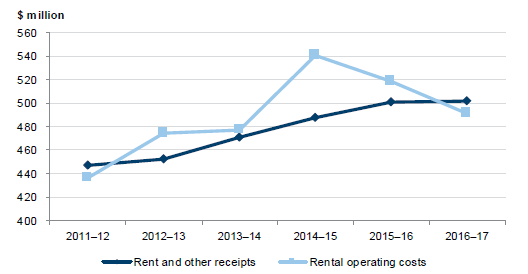
Note: Rental operating costs in 2011–12, 2012–13 and 2013–14 are unreliable due to DHHS misallocating some maintenance as minor capital works and vice versa.
Note: 2016–17 figures are estimates only.
Source: VAGO, based on data from DHHS.
In 2014–15, DHHS recognised that some public housing maintenance expenditure was being incorrectly recorded as capital works—and therefore was not being reflected in operating costs—and vice versa. From 2014–15 onwards, DHHS has worked to reclassify any misallocated maintenance and capital works. Rental operating costs reported during 2011–12, 2012–13 and 2013–14 are less reliable because of this error.
Director of Housing cash position
Figure 2D shows that the cash balance for the Director of Housing steadily increased after 2013–14.
Figure 2D
Cash balance of the Director of Housing, 2011–12 to 2015–16
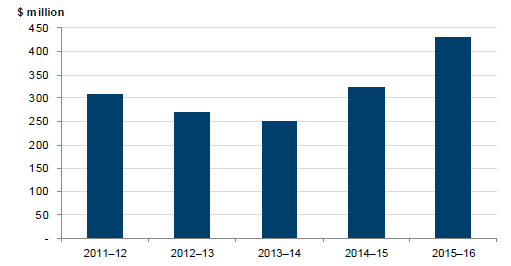
Source: VAGO, based on data from DHHS.
Net operating cash flow
The 2017–18 Victorian Budget papers report that the Director of Housing (along with VicTrack) remains in a financially sustainable position based on net operating cash flow surpluses forecast to average $130 million per year between 2017–18 and 2020–21. This is consistent with DHHS' financial data from recent years that shows the Director maintaining an average net operating cash flow surplus of $124 million per year since 2011–12.
However, these surpluses include significant Commonwealth and State grants and subsidies provided to the Director of Housing. Based on DHHS' financial data these grants and subsidies have averaged $435.9 million per year since 2011–12. Therefore, the ongoing financial sustainability of public housing is heavily reliant on this funding continuing.
An April 2017 'cost-mapping' review commissioned by DPC on the Director of Housing's financial and operational performance also highlighted this issue. It found that the Director's financial viability may be compromised if Commonwealth funding lapses.
Managing financial results
DHHS has managed its cash position since the 2012 audit, partly by:
- postponing renewal programs, which has accelerated deterioration of public housing stock and increased the maintenance backlog liability
- postponing stock acquisitions and disposing of inappropriate public housing stock, which has contributed to total stock decreasing by 200 dwellings between 2012 and 2016
- removing a $35 cap on rent increases for public housing tenants who pay market-level rent.
While these strategies have improved the short-term financial performance of public housing, they are not sustainable over the medium to long term.
One way to measure the impact of DHHS' deferral of public housing renewal programs is to measure growth in the accrued maintenance backlog liability—which represents incomplete maintenance work scheduled to occur in a year that has passed. The backlog's accrued liability increased from $22 million in 2013 to $227.5 million in 2016.
DHHS advises that this result is misleading because:
- it deliberately over-schedules planned maintenance each year to account for the fact that it will not gain access to all properties
- its accrued maintenance backlog does not account for DHHS' decision not to fund maintenance on properties identified for a future upgrade or disposal.
2.2.3 Ageing stock
Our 2012 audit reported that: 'Forty-two per cent of housing stock is over 30 years old' and 'The public housing portfolio is now in a seriously deteriorating condition with the division estimating that 10 000 properties, 14 per cent of the total, will reach obsolescence over the next four years'.
In 2016, the average age of Victoria's public housing stock was 35 years old, just above the median age of 32 years. In total, 60 per cent of public housing stock is over 30 years old—an increase of 18 per cent in the four years since the previous audit.
Figure 2E shows the current age profile of all public housing stock in Victoria and the corresponding total accrued and projected two-year maintenance liability for each age category. The maintenance liability is highest for stock between 31 and 40 years old.
Figure 2E
Age profile of public housing stock and total maintenance liability
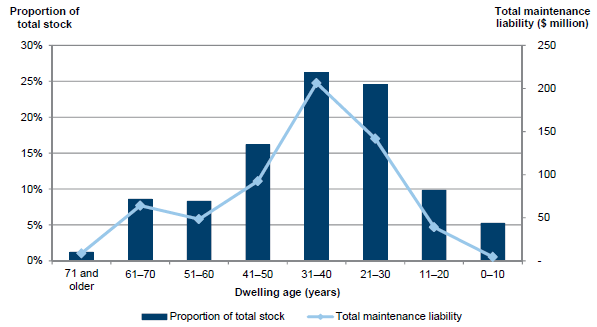
Source: VAGO, based on data from DHHS.
Figure 2F shows both the average maintenance liability and condition rating per dwelling by the same age groups. In particular, it shows that dwellings aged between 41 and 60 years old have a higher average condition rating and a lower average maintenance liability than dwellings aged between 31 and 40 years. DHHS advises that this is a result of targeted upgrade works undertaken on ageing stock.
Figure 2F
Average maintenance liability and condition rating per dwelling by age
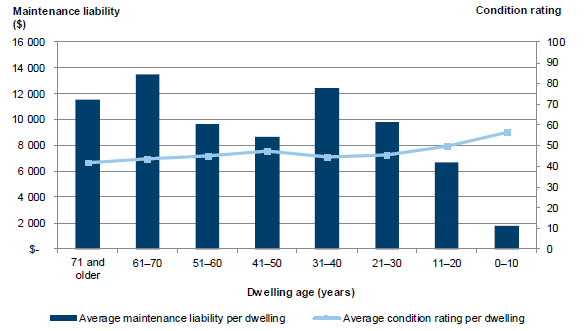
Source: VAGO, based on data from DHHS.
2.2.4 Unmet demand
Our 2012 audit reported that: 'The demand for public housing has exceeded supply over the audited period of the past 10 years. The cost of living and household numbers have increased and the availability of affordable housing has decreased.'
Public housing waiting list
Figure 2G shows that between 2010–11 and 2015–16, the total waiting list for public housing reduced by 16 per cent, while the number of applicants on the early housing waiting list—typically reserved for people who are homeless, disabled or have other complex needs—has reduced by 1 per cent. However, this trend does not provide a true picture of both expressed and unexpressed demand for social and affordable housing over time.
Figure 2G
Public housing waiting list, 2010–11 to 2015–16
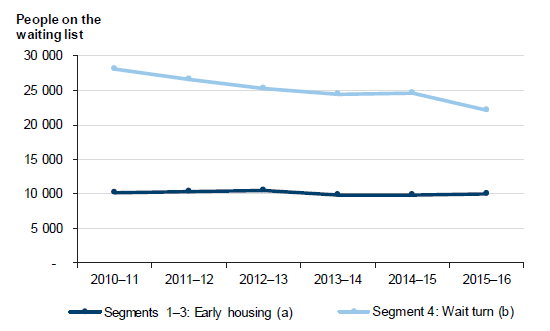
(a) Priority segments 1–3 make up the early housing waiting list, which includes higher-need applicants who are given priority access to public housing.
(b) Priority segment 4 includes low-income households that may benefit from public housing.
Note: Numbers are as at 30 June each year.
Source: VAGO, based on data from DHHS.
Unmet demand across public and community housing
At September 2016, the Victorian Housing Register—a replacement for the former Public Housing Waiting List—had 33 073 applicants for public housing. Of these, over 10 000 applicants were placed on the early housing waiting list.
A report on future social housing requirements commissioned in 2016 by the Family Violence Housing Assistance Implementation Taskforce estimated that Victoria's public and community housing—that is, social housing—stock would need to increase by around 40 per cent to house all applicants on the Victorian Housing Register.
In 2013, the former Department of Human Services commissioned modelling to estimate expressed and unexpressed unmet demand for social housing in Victoria between 2011 and 2021. The modelling defined unmet demand as households in the private rental market that are eligible for social housing and pay more than 30 per cent of their income on rent. The results projected that unmet demand would increase from 53 826 households in 2011 to 65 796 by 2021. This equates to a 22 per cent increase over 10 years, or an annual growth rate of 1 197 households. However, this modelling was limited by the fact it did not account for any growth in social housing over time.
More recently in December 2016, Victoria's 30-Year Infrastructure Strategy estimated that unmet demand for social housing may already be greater than the 2021 projections in the previous study. Specifically, the strategy estimated that between 75 000 and 100 000 vulnerable low-income households do not have access to affordable housing.
Stock of public housing
Victoria's public housing stock has not grown to meet increasing demand. The total public housing stock declined by 581 dwellings between 2006 and 2016, largely due to DHHS disposing of 6 466 public housing dwellings over the same period.
Figure 2H shows that:
- 49 per cent of unit disposals since 2006 have occurred through demolitions
- 31 per cent of unit disposals have occurred through sales.
Figure 2H
Public housing disposals by type, 2006 to 2016
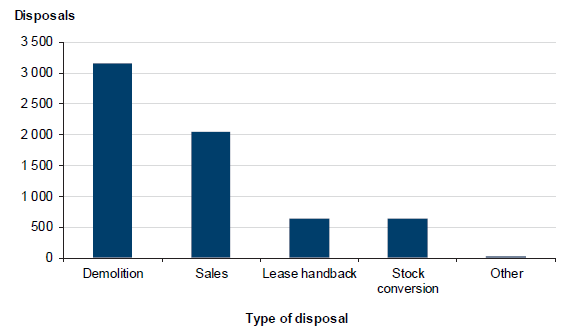
Note: 'Lease handback' includes short-term head leases that DHHS has returned to the owner.
Source: VAGO, based on data from DHHS.
In contrast to the net decline in public housing stock, long-term community housing stock increased by 9 593 dwellings—or 81 per cent—between 2006 and 2016. This increase is largely due to state and Commonwealth investment to fund acquisition of community housing.
Taken together there has been a net 12 per cent increase in social housing dwellings across Victoria since 2006, but this has not kept pace with the growth in all dwellings.
As shown in Figure 2I, the amount of social housing as a proportion of all occupied dwellings declined from 3.8 per cent to 3.47 per cent over the same period—which is well short of the current national average of 4.5 per cent. Victoria's share also falls short of New South Wales' and Queensland's, which were 5.2 per cent and 3.9 per cent respectively in 2015.
Figure 2I
Social housing in Victoria as a proportion of all occupied dwellings
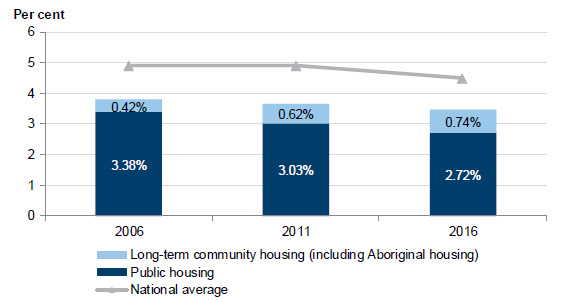
Source: VAGO, based on data from DHHS.
A 2016 report commissioned by the Family Violence Housing Assistance Implementation Taskforce estimates that reaching the 4.5 per cent national average would require up to 3 400 new social housing dwellings per year until 2036.
We note that the taskforce has recently begun work to gain a better understanding of current and future demand for different types of housing assistance, including social housing. This work needs to be accounted for in DHHS' future work to understand and address challenges in the supply of and demand for public housing.
Prioritising public housing for critical-need applicants
With insufficient public housing stock to meet demand, DHHS has prioritised allocations for people in critical need. This is shown in Figure 2J.
Figure 2J
Public housing applications, allocations and average waiting times, 2015–16
| Priority segment | Description | 2015–16 applications | 2015–16 allocations | Average wait (months) |
|---|---|---|---|---|
|
Segment 1— Homeless with support |
Applicants who are homeless or experiencing family violence |
5 943 |
2 384 |
8.8 |
|
Segment 2— Supported housing |
Applicants who require 'major' or 'full' modifications to their housing |
1 072 |
220 |
9.9 |
|
Segment 3— Special housing needs |
Applicants who are in insecure, unsafe or inappropriate housing, or who have a serious medical condition |
6 036 |
1 114 |
16.2 |
|
Other early housing |
Applicants from minor segments such as 'temporary absence' and 'relocation due to fire' |
318 |
412 |
4.6 |
|
Segment 4— Wait turn |
Low-income households that may benefit from public housing |
26 326 |
798 |
23.6(a) |
|
Total waiting list |
39 695 |
4 928 |
10.4(b) |
(a) DHHS calculates allocation waiting times for the 'wait turn' segment using a different method to other segments.
(b) DHHS excludes the 'wait turn' segment from its overall average wait time.
Note: Allocations may exceed applications in any given year.
Source: VAGO, based on data from DHHS.
Figure 2K shows that DHHS has been increasingly allocating its public housing to critical–need applicants since 2011–12.
Figure 2K
Victorian public housing allocations to those in greatest need, 2010–11 to 2014–15
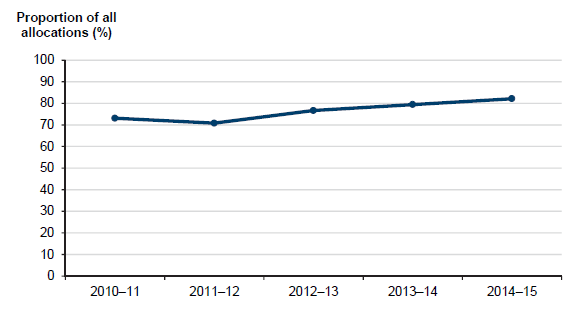
Source: VAGO, from the 2016 Report on Government Services, Productivity Commission.
Despite an increasing focus on allocating public housing to critical-need applicants, the average waiting time for each priority segment has remained relatively stable over time. This is shown in Figure 2L.
Figure 2L
Average waiting time to be allocated public housing, 2011–12 to 2015–16
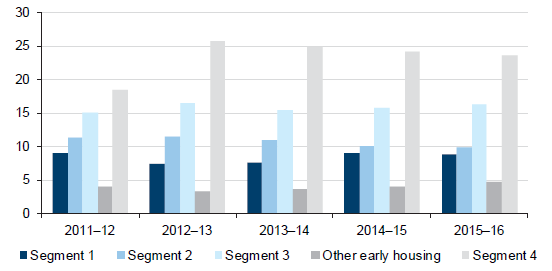
Source: VAGO, based on data from DHHS.
Achieving shorter waiting times requires both the development of new properties and tenants leaving the public housing system at a sufficient rate. The rate at which tenants leave the system is heavily influenced by economic factors and the housing market.
2.2.5 Stock misalignment with demand
Our 2012 audit reported that: 'The portfolio contains too many large properties, while current demand is for single bedroom accommodation' and 'A significant mismatch now exists between public housing stock and the needs of current and future tenants'.
Consistent with the 2012 audit, Victoria's public housing portfolio in 2016 is not configured to meet the growing demand for one- and two-bedroom dwellings, which account for around 80 per cent of applicants. There are more three-bedroom dwellings than any other configuration. Overcoming this challenge in the short-term is very difficult due to the high cost and disruptive nature of reconfiguring public housing stock.
Figure 2M illustrates the extent of the misalignment between existing stock and demand—it shows that the number of one-bedroom dwellings would have had to nearly double to meet demand during 2015.
Figure 2M
Public housing waiting list demand by number of bedrooms compared to stock configuration, 2015
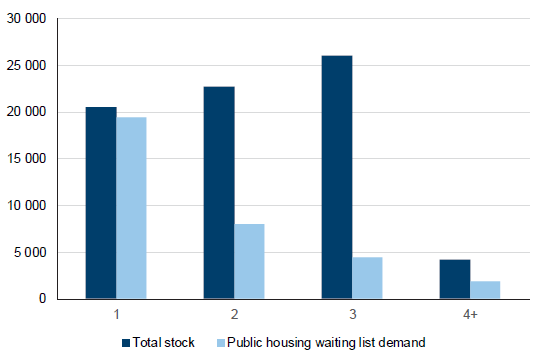
Note: 'Total stock' includes all public housing stock available to the Director of Housing.
Source: VAGO, based on data from DHHS.
Figure 2N shows the bedroom composition of public housing stock by dwelling age. In particular, it shows that the proportion of three-bedroom dwellings that are less than 10 years old is low. Despite this shift, DHHS advises that it needs to expand its three-bedroom stock along with other stock sizes to comprehensively meet future demand.
Figure 2N
Age of public housing dwellings by number of bedrooms
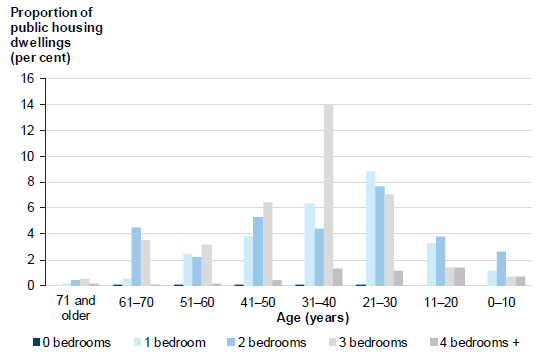
Source: VAGO, based on data from DHHS.
DHHS does not optimise the use of its stock by relocating tenants as their circumstances change. This approach challenges the equity of the public housing system because it allows people to stay in public housing after they no longer need public housing support. It also limits DHHS' capacity to optimally match applicants with the most appropriate stock, although the limited availability of smaller dwellings already makes this challenging.
Tenant transfers and mutual swaps
The mismatch between tenant need and available stock has contributed to significant unmet demand for tenant transfers to other public housing dwellings, which is reflected on a transfer waiting list. In particular, between 2010–11 and 2015–16:
- the waiting list for tenant transfers made up 12 per cent of all public housing households
- DHHS granted tenant transfers each year to between 15 and 22 per cent of those on the transfer waiting list.
One way that transfers can be processed is through mutual swaps, where one public housing tenant can swap homes with another if certain eligibility conditions are met. However, only 87 mutual swaps have been processed since 2011–12. DHHS currently does not provide a matching service for mutual swaps, and this has encouraged tenants to seek these out independently through other channels including social media.
In February 2017, DHHS committed to improving this program, to facilitate more efficient tenant matching. This is expected to involve:
- training housing officers to use the mutual swap function in DHHS' main public housing information system
- updating and clarifying policies for mutual swaps.
DHHS advises that the introduction of the Victorian Housing Register as a replacement for the Victorian Public Housing Waiting List—discussed further in Part 3—is expected to help facilitate future mutual swaps. It aims to do this by raising the priority of applications from households wishing to downsize to a smaller dwelling—the most common reason for mutual swap applications.
3 Improving public housing
This Part of the report assesses ongoing work to improve public housing in Victoria, which has occurred primarily through:
- development of the Victorian housing affordability strategy, Homes for Victorians, which was released in March 2017
- implementation of the Victorian Housing Register, which aims to consolidate the former Public Housing Waiting List and various community housing waiting lists
- departmental initiatives aimed at addressing public housing sustainability issues and preparing for the delivery of relevant strategy initiatives.
These initiatives, especially Homes for Victorians, will play a critical role in addressing longstanding public housing challenges, including those highlighted in this report.
As these initiatives are either in development or being implemented, this Part focuses on:
- whether the public housing-related components of Homes for Victorians were underpinned by sound advice to government
- the development and implementation of work completed to date on other initiatives aimed to address public housing challenges.
3.1 Conclusion
Homes for Victorians and its supporting initiatives reflect an increased focus on increasing the supply of public housing and driving a more integrated service delivery model with the community housing sector.
The development of Homes for Victorians was underpinned by an extensive range of advice to government on proposed public housing measures, with the three audited departments—the Department of Health and Human Services (DHHS), the Department of Premier and Cabinet (DPC) and the Department of Treasury and Finance (DTF)—making significant contributions. While this is positive, gaps in this advice limit the clarity of Homes for Victorians' expected impact on social housing demand and the viability of community housing providers, which are now expected to allocate more housing to critical-need applicants.
3.2 Developing Homes for Victorians
Homes for Victorians was released in March 2017. This strategy aims to address public housing challenges through a broad set of social housing measures. This reflects the shared roles of both the public and community housing sectors in providing affordable housing options for low-income and disadvantaged Victorians. Appendix B details the measures included in Homes for Victorians that relate to social housing. Key measures include:
- growing social housing stock through construction of new dwellings and redevelopment of up to 2 500 public housing dwellings
- supporting growth in the community housing sector by:
- enabling it to access finance on more favourable terms
- transferring management of 4 000 public housing properties to the community housing sector.
Another initiative outlined in Homes for Victorians is the Victorian Housing Register, which was launched in September 2016. Although it is not yet fully implemented, the register aims to consolidate the former public housing and community housing waiting lists. We examine development of the register in more detail in Section 3.3.
The measures in Homes for Victorians introduce some innovative approaches for delivering both public and community housing, including:
- establishing a $1 billion Victorian Social Housing Growth Fund to:
- establish partnerships with the private sector to deliver additional social housing dwellings
- provide subsidised rental tenancies from the private market for people who need housing assistance but may not require intensive long-term housing
- increasing housing supply through faster planning—this includes, but is not limited to an Inclusionary Zoning Pilot Program that involves selling surplus government land at a discount and, in return, making social housing a set proportion of new construction.
The above measures respond to issues raised in our 2012 audit, such as unmet demand, stock misalignment and the need for alternative funding models for public housing.
Other measures in Homes for Victorians have the potential to impact on public housing demand, such as:
- a $152 million investment to extend housing support for victims of family violence
- a $109 million investment to move homeless Victorians towards stable housing
- a $33 million investment to extend private rental assistance to disadvantaged Victorians
- a $30 million investment to upgrade rooming houses.
Homes for Victorians does not set a clear overarching strategic direction or any targets for public housing growth and sustainability. This will be a challenge for any future evaluation of its impact. DHHS will need to establish a direction that aligns with Homes for Victorians and sets long-term targets for public housing provision.
3.2.1 Advice and analysis underpinning Homes for Victorians
Homes for Victorians has been informed by an extensive range of work including:
- formation of a parliamentary committee in September 2015 to coordinate the government's approach to housing affordability reforms
- an inter-jurisdictional comparison of social housing reforms prepared in November 2015
- a broad housing affordability review that was completed in January 2016 by an independent panel
- a review of the financial sustainability of the public housing operating model in October 2015 and June 2016
- development of various potential strategy measures to grow and sustain social housing by the three departments, along with government's consideration of these.
It is underpinned by detailed consideration of housing affordability issues, including existing social housing deficiencies and risks, social housing practices in other jurisdictions, and potential measures to grow and sustain social housing. In particular, key challenges facing public housing in Victoria—including financial sustainability, unmet demand, ageing stock, and the lack of an overarching strategic direction—were identified early and considered throughout the strategy's development.
However, neither Homes for Victorians nor the advice supporting its development have sufficiently measured the likely impact of funded initiatives on current and projected demand for social housing. This makes it unclear to what extent Homes for Victorians will translate into meaningful growth in social housing and address known challenges in this sector. Nevertheless, the funded measures in Homes for Victorians will not be enough for Victoria to meet the national average of social housing making up 4.5 per cent of all occupied housing, although this is not an explicit goal. As noted in Section 2.2.4, reaching the national average is estimated to require up to 3 400 new social housing dwellings each year until 2036.
3.2.2 The future role of the community housing sector
Homes for Victorians includes a focus on growing the community housing sector. Growing this sector could potentially address current public housing challenges by:
- reducing unmet demand for public housing
- increasing the supply of one- and two-bedroom dwellings to align with the current profile of public housing tenants
- reducing the level of deteriorating or obsolete public housing stock, which in turn would reduce the Director of Housing's operating costs.
While this approach has the potential to address longstanding public housing challenges, it also creates risks for the viability of community housing that need to be carefully managed.
The community housing and public housing models differ in two key ways:
- The community housing model typically provides housing to a more diverse range of low-income Victorians, while the public housing model focuses on those in greatest need. However, DHHS advised that some providers do focus their housing allocations more in line with a public housing model.
- Community housing providers can subsidise their operations with Commonwealth Rent Assistance and charitable tax exemptions. Neither is available to the Director of Housing.
These differences give the community housing sector added flexibility to operate sustainably. However, it is still a relatively new sector with varying capability.
The measures in Homes for Victorians that focus on growing the community housing sector and changing its role include:
- moving to a multi-provider delivery model for future social housing growth and redevelopment—this model uses the collective capacity and skills of the public, not-for-profit and private sectors to deliver a social housing redevelopment pipeline
- providing financial backing for the community housing sector through:
- a $100 million loan facility that will provide low-cost, long-term subordinate loans to housing associations
- a loan guarantee program valued at up to $1 billion to help housing associations access finance at affordable rates
- establishing a $1 billion Social Housing Growth Fund to fund a pipeline of projects to deliver more public and community housing
- requiring community housing organisations that opt in to using the Victorian Housing Register to allocate 75 per cent of vacancies to applicants with critical needs.
Transferring management of 4 000 public housing dwellings to the community housing sector is another measure included in Homes for Victorians. This benefits the Director of Housing by transferring a proportion of the public housing portfolio's maintenance liability, which is partially offset by lost rental income. Management transfers can also offer limited opportunities for the community housing sector to leverage finance to grow stock further, although a longer lease term could provide a more sustained revenue stream that can be leveraged for growth.
Transfers of stock ownership typically provide greater growth opportunities—most recently, in September 2016, the Director of Housing committed to transferring ownership of 1 448 public housing properties to Aboriginal Housing Victoria. To date, 511 properties have been transferred. DHHS advised that the reason for this transfer was to give Aboriginal communities greater self-determination, rather than to increase housing stock.
Advice to government showed that these considerations were analysed in detail as part of the development of Homes for Victorians. However, this advice lacked a clear assessment of the expected financial and operational impacts of these measures on the community housing sector—in particular, the requirement for community housing providers to allocate 75 per cent of housing to applicants with critical needs, which could potentially constrain rental revenues and put the sector's financial viability at risk. These considerations need to be balanced carefully against the needs of the most disadvantaged Victorians.
As shown in Figure 3A, DHHS commissioned two prior reviews of the community housing sector's capability and capacity to receive transfers of public housing stock. While these reviews highlight the sector's capability and capacity, they also highlight uncertain impacts depending on the terms of the transfer. In particular, the second review in 2015 recommended further work to understand the financial implications of stock transfers on community housing providers. This work has not been completed, although DHHS advised that it will address this gap through the terms of transfer of 4 000 dwellings in 2018.
Figure 3A
Reviews commissioned by DHHS on community housing capability
and capacity
|
Review |
Purpose |
Key findings |
|---|---|---|
|
Assessing the Capacity of the Community Housing Sector (2013) |
To test the capacity of community housing associations to receive additional housing stock as part of a hypothetical stock transfer from government. |
|
|
Stock Transfer to the Community Housing Sector—Strategic Options Assessment (2015) |
To assess potential options, opportunities and issues associated with transferring up to 12 000 public housing dwellings to the community housing sector. |
|
Source: VAGO.
3.2.3 Implementation planning underway
To maximise the impact of Homes for Victorians in addressing public housing challenges, its implementation needs to be supported by robust planning. DHHS, DPC and DTF have already taken positive steps by establishing the Interdepartmental Housing Project Steering Committee in June 2016. In part, this committee will oversee implementation of Homes for Victorians' social housing initiatives by:
- ensuring that actions supporting each initiative align with their policy intent
- monitoring the development of business cases and projects
- setting appropriate governance arrangements for social housing redevelopments.
To date, the committee has met three times—in September 2016, March 2017 and May 2017. It has focused on establishing processes to support implementation of Homes for Victorians' social housing measures, incorporating stakeholder engagement arrangements. It has also focused on monitoring DHHS' planning for the delivery of 10 site-specific capital upgrades under Homes for Victorians' $185 million Public Housing Renewal Program, which proposes to redevelop up to 2 500 public housing dwellings over four years.
It will be important for the committee to evaluate the outcomes achieved by all social housing initiatives in Homes for Victorians during and after implementation. This task is made more challenging by the strategy's lack of clear overarching targets for social housing growth and sustainability.
The Family Violence Housing Assistance Implementation Taskforce is also performing a range of work to support delivery of Homes for Victorians, including:
- establishing a working group focused on safe, affordable and suitable housing supply—this working group will determine the number of additional social housing units needed for family violence victims who are unable to access and sustain private rental accommodation
- commissioning work to estimate the shortage of long-term social housing in Victoria and inform more detailed modelling of long-term housing demand and supply, with a focus on family violence
- planning for independent evaluations of initiatives funded under the $152 million Family Violence Housing Blitz package.
The Interdepartmental Housing Project Steering Committee and the taskforce will need to work closely together to monitor, evaluate and report on the social housing-related components of Homes for Victorians.
3.3 Moving to a consolidated waiting list
In September 2016, DHHS launched the Victorian Housing Register, which aims to consolidate the former public housing and community housing waiting lists. The new register improves on prior arrangements in two key ways. First, new applicants need only apply once for public and community housing using an online application form. Second, consolidating the various waiting lists gives a clearer picture of social housing supply and demand.
The register is supported by the Housing Amendment (Victorian Housing Register and Other Matters) Act 2016 (the Act). The Act provides statutory power for the Director of Housing to establish and administer the register as a centralised social housing waiting list. The Act also:
- enables community housing providers to share applicant information that is needed for the register to operate
- empowers the Director of Housing to set requirements for how people on the register are allocated available social housing.
The effectiveness of the register will be heavily influenced by community housing providers' willingness to participate, because it is not compulsory. However, Homes for Victorians limits its community housing funding to providers that opt in to using the register.
3.3.1 Implementation progress
To date, the register has been established and the existing waiting list for public housing has been transferred to it. The register is expected to be fully operational by December 2017. Important work yet to be completed includes training community housing organisations in how to use the register, and importing community housing waiting lists.
The governance arrangements in place to support delivery of the register are adequate:
- A leadership group provides advice on the register's design and delivery. It is led by DHHS and comprises members from the community and Aboriginal housing sectors, homelessness experts and tenant advocacy groups. The leadership group has met monthly since October 2015.
- A supporting working group coordinates implementation and oversees operation of the register. It comprises members from DHHS and the community housing sector and has met 11 times since November 2015.
DHHS has developed detailed guidelines to support the register's operation. The guidelines cover processes across three stages—application, assessment and allocation.
3.3.2 Remaining challenges
Implementation challenges remain which, if not carefully addressed, could limit the impact of the Victorian Housing Register.
In administering the register, the Director of Housing has the power to require participating community housing providers to allocate a greater proportion of vacancies to applicants with critical housing needs. This has led to Homes for Victorians including a requirement for participating organisations to allocate 75 per cent of housing to those in greatest need in order to access any of its funded initiatives.
As outlined in Section 3.2.2, mandating allocation requirements for the community housing sector could potentially ease pressure on the public housing operating model—although this is not an explicit goal—and could improve outcomes for the most disadvantaged Victorians. But it could also reduce the financial viability of participating community housing providers by constraining their rental revenue. The community housing sector expressed concern about these potential new requirements during the development of the register.
Further work is needed to understand financial and operational impacts of these new allocation requirements on the community housing sector.
Other implementation issues that DHHS needs to manage include:
- the process of merging community housing waiting lists into the register—there is a risk that this will generate duplicate records, which would artificially increase the number of applicants on the register and misrepresent demand
- training participating housing providers in how to use the system and comply with its requirements—this is yet to occur, although DHHS plans to roll out a training program before the register is fully implemented.
3.4 Departmental initiatives
Longstanding public housing challenges persist, with issues such as unmet demand expected to continue beyond the implementation of Homes for Victorians. However, two recent departmental initiatives show a more concerted effort to address longstanding issues.
3.4.1 Interdepartmental Housing Project Steering Committee
In addition to overseeing delivery of social housing initiatives in Homes for Victorians, the Interdepartmental Housing Project Steering Committee also plans to address sustainability challenges in the public housing operating model. Specifically the committee has committed to:
- examining issues that impact on the sustainability of the Director of Housing's budget
- determining whether current regulatory and administrative arrangements can effectively support the Director of Housing and the community housing sector
- supporting enhancement of DHHS' capacity to improve outcomes and community services for tenants
- considering work undertaken by the Family Violence Housing Assistance Implementation Taskforce to provide broader strategic advice on reform in homelessness, social and affordable housing.
To date the committee has met three times—in September 2016, March 2017 and May 2017. Beyond its work to support delivery of Homes for Victorians, the committee's work has focused on:
- monitoring the Director of Housing's financial position—including DHHS working to rectify an issue where public housing maintenance works have been incorrectly charged as minor capital works, distorting the underlying financial result
- considering development of a new framework of tenant incentives and
disincentives to change their behaviour and increase the efficiency of the
public housing system—this framework has the potential to:
- improve public housing allocations to new tenants, for example by providing an incentive for applicants to honestly declare their housing needs
- reallocate existing stock among current residents, for example by providing an incentive for tenants to swap or relocate their tenancy
- accelerate sustainable exits from the public housing system into alternative housing.
3.4.2 Review of options to optimise and grow social housing
In 2016, DHHS engaged a consultant to identify and assess options to optimise and increase social housing assets in Victoria. The review developed and prioritised 19 options to address current and future challenges and inform development of DHHS' next social housing asset strategy. Figure 3B shows the prioritised list of seven options that the review recommended for further analysis.
Figure 3B
Shortlist of recommended options to optimise and grow social
housing, in order of priority
|
1. Seek new capital funding sources from government to increase stock numbers or improve condition of stock 2. Collaborative procurement with non-government entities to leverage capabilities and deliver an increase in net stock 3. Transfer of stock and/or management transfer to the private sector 4. Recycling of assets and capital in the existing portfolio 5. Collaboration with other government entities for asset redevelopment schemes 6. Provide capital grants to community housing providers (for acquisitions) 7. Review of tenant relocation policies to optimise the utilisation of current stock |
Source: VAGO, based on information from DHHS.
The Interdepartmental Housing Project Steering Committee provides a suitable platform to further investigate and develop these options.
4 Improving asset management
This Part of the report assesses the Department of Health and Human Services' (DHHS) implementation of asset management recommendations from our 2012 performance audit Access to Public Housing.
Figure 4A shows the four recommendations we made about public housing asset management.
Figure 4A
Summary of progress against 2012 audit recommendations relating to public housing asset management
|
The [former] Department of Human Services should: 4. develop a comprehensive asset management strategy and vigorously monitor performance 5. at the regional level, capture local knowledge and communicate investment criteria 6. update and strengthen property condition data across the portfolio 7. apply relevant data and medium- and longer-term forecasts to asset management strategies. |
Source: VAGO.
In performing our assessment, we have drawn on the best-practice principles detailed in the Department of Treasury and Finance's (DTF) current and past asset management frameworks, including the:
- 2016 Asset Management Accountability Framework(AMAF)
- 2000 asset management policy statement, Sustaining Our Assets
- 1994 Asset Management Series.
Among other things, these frameworks highlight the importance of:
- adopting a full life cycle approach for asset planning and decision-making, covering planning, acquisition, operation and disposal
- establishing processes to identify, monitor and record the condition of assets
- understanding current and forecast service delivery needs.
We have also drawn upon the principles detailed in the Cooperative Research Centre for Infrastructure and Engineering Asset Management's Integrated Strategic Asset Management for Experts.
4.1 Conclusion
DHHS has undertaken a range of work since the 2012 audit to improve its management of public housing assets. Its development of a five-year asset strategy in 2014 has been central to this.
Despite this work, DHHS' public housing asset management framework—in its current state—remains disjointed, poorly communicated, and out of date in key areas. DHHS lacks a comprehensive understanding of its asset management performance—a result of dysfunctional governance arrangements, minimal performance measures and ineffective arrangements for collecting property condition data. These weaknesses impair DHHS' ability to make informed decisions about asset planning.
We acknowledge that DHHS' capacity to establish and maintain a sound asset management framework since the 2012 audit has been challenged by machinery-of-government changes, along with multiple changes to its internal structures.
Encouragingly, DHHS is already working to address a number of identified issues. In particular, its planned update to the 2014 asset strategy provides a valuable opportunity to drive significant improvement.
4.2 Progress against our 2012 recommendations
To date, DHHS has responded to our recommendations by:
- developing its 2014 asset strategy, and beginning work in 2016 to update the strategy
- commissioning a condition audit of nearly 73 000 of its 76 000 social housing properties in 2013–14
- commencing work in 2016 to improve how regional input contributes to centralised asset planning decisions
- establishing four divisional (regional) capital advisory committees from 2014 onwards
- starting development of divisional asset plans in 2016.
Although DHHS has acted in response to each recommendation, we found that not all of them have been fully addressed.
4.3 Developing an asset strategy
Our 2012 audit reported that: 'Such a large property portfolio warrants comprehensive asset management, yet there is no current asset strategy. [The former Department of Human Services' Housing and Community Building Division's] past asset management strategies lacked basic elements such as annual updating, consideration of the full life cycle of assets, and comparison of current to desired stock, in terms of size or location.'
An asset strategy is a critical component of any asset management framework. It should guide and optimise asset management decisions at each stage of the life cycle.
We assessed whether DHHS' asset strategy for public housing:
- has driven a whole-of-life cycle approach to asset management
- establishes an effective performance monitoring and governance framework
- has been informed by current and forecast service demand
- aligns with relevant government policies and frameworks.
DHHS has operated without an up-to-date asset strategy for much of the time since the 2012 audit. It drafted an interim asset strategy for use in 2012–13 and 2013–14, although this strategy was not finalised due to departmental reforms and structural changes. In 2014, DHHS developed its five-year asset strategy, which is still in use. The 2014 strategy was due to be reviewed in February 2015 and then yearly, although this has not occurred. Much of the strategy's content is now outdated.
Overall, we found that DHHS' 2014 strategy and supporting implementation plans do not:
- reflect a systematic or transparent life cycle approach to managing assets, although the recent development of asset intent guidelines is a positive development
- establish a useful performance monitoring regime for assets or the strategy itself
- reflect a systematic or comprehensive understanding of service demand over the medium to long term.
DHHS advised that it chose not to widely distribute the 2014 strategy among staff to prevent internal disagreement about the strategy's proposed approach to managing assets. It advised that instead, departmental board members were given the discretion to distribute the strategy. However, there is no explicit mention of this in the minutes from board meetings.
We recognise that DHHS is now updating the asset strategy to align with the Victorian housing affordability statement, Homes for Victorians, and Infrastructure Victoria's 30‑year plan. It is important that any updates address these weaknesses. We also note that DHHS has created the executive position of Director, Housing Asset Strategy and Financing to support work in this area.
4.3.1 Asset management priorities and initiatives
An asset strategy should consider various options to achieve the desired service delivery results and assess the costs, benefits and risks associated with each option.
As shown in Appendix C, DHHS' 2014 asset strategy sets a range of priorities to address demand, condition, financial and social drivers. In setting these priorities, the strategy considers:
- the profile of social housing tenants and existing stock
- under-utilisation of dwellings, which covers occupied dwellings with unused bedrooms
- social housing allocations and demand
- the 10-year maintenance and repair liability cost
- the underlying financial position of the public housing portfolio
- other interdependent elements that have an impact on public housing asset management, including tenancy management, asset standards and data accessibility and integrity.
The strategy's priorities include, but are not limited to:
- addressing demand through acquisition and construction of one- and two‑bedroom dwellings, and disposal of dwellings in poor condition where demand is low
- improving the condition of assets by disposing of or redeveloping dwellings with high maintenance costs, as well as acquiring and developing dwellings with sustainable life cycle costs
- reducing operating costs by selling high-value stock and transferring stock to the community housing sector.
The strategy identifies nine possible asset initiatives to address the above priorities, listed in Figure 4B.
Figure 4B
2014 asset strategy initiatives
|
Asset renewal initiatives |
Asset management initiatives |
|---|---|
|
Simplified public–private partnerships or development agreements for larger, more complex inner-city sites |
Consider transfer of stock to community housing sector |
|
Strategic divestment and acquisition program—sale of high value unit and apartment sites |
Efficient utilisation of dwellings—proactive engagement with tenants in underutilised dwellings |
|
Maintenance and upgrades |
Expand moveable units program |
|
Self-funding suburban renewal |
Energy efficiency programs |
|
Holistic tenancy and asset management |
Source: VAGO.
While the strategy follows a methodical process for setting its asset management priorities, content on these nine possible asset initiatives lacks the necessary detail to make clear:
- which asset priorities are being addressed by each initiative
- the benefits, risks and costs of each initiative—instead, the strategy only makes a superficial assessment of these aspects.
Additionally, the strategy lacks clearly defined levels of service for public housing assets, which limits clarity about the adequacy and expected impact of identified initiatives. We discuss this further in Section 4.3.3, which assesses the asset strategy's performance monitoring regime.
4.3.2 Applying a life cycle approach
Our 2012 audit reported that: 'The two asset management strategies do not apply a systematic and comprehensive life cycle approach across the housing portfolio.'
Asset management strategies and supporting implementation plans are needed to guide decision-making at each stage of the asset life cycle—planning, acquisition, operation and disposal.
Life cycle plans
Life cycle plans should specify how assets will be managed to achieve the objectives of the asset strategy. They provide asset decision-makers with a clear framework that addresses identified gaps and meets service delivery needs in each phase of the asset's life cycle. Appendix D details the expected features of asset life cycle plans.
DHHS' 2014 asset strategy commits to developing annual capital plans that:
- set annual acquisition and disposal targets for the next four financial years
- summarise estimated budgets for acquisitions, upgrades and maintenance over the next four financial years.
These annual capital plans will be supported by an acquisition plan, a development plan, a maintenance plan and a disposal plan.
However, beyond its annual capital plans, DHHS has not developed supporting life cycle plans that meet the requirements of its 2014 asset strategy and clearly show how annual budgets and targets were informed.
Figure 4C shows the planning approach that underpins each stage of DHHS' asset life cycle.
Figure 4C
DHHS' asset planning approach by life cycle stage
|
Life cycle stage |
Asset planning approach |
|---|---|
|
Acquisition |
|
|
Operations |
|
|
Maintenance |
|
|
Redevelopments and upgrades |
|
|
Disposal |
|
Source: VAGO.
DHHS undertakes a range of work to support its annual capital plans and inform its asset planning decisions. However, this work does not:
- comprehensively address the life cycle planning requirements detailed in Appendix D
- clearly and systematically link to the overarching asset strategy and its identified service delivery requirements
- reflect an integrated approach to asset planning decision-making across all life cycle stages.
Nominating asset intent
Since our 2012 audit, DHHS has developed and refined a framework for assessing the intent of individual public housing assets. Under this framework, assets are placed on one of four pathways—hold and develop, redevelop, sell or plan for disposal, and review. These pathways, outlined in the 2016 version of the asset intent framework, are described in Figure 4D.
Figure 4D
Asset intent framework for public housing assets
|
Asset intent |
Description |
|---|---|
|
Hold and improve |
Retain the property, as it meets DHHS' asset objectives and continues to be a productive asset to be maintained and potentially improved. |
|
Redevelop |
Retain the land, as it meets objectives, and put in place the necessary planning processes to demolish existing building(s) and construct new dwelling(s) on the site. |
|
Sell, or plan for disposal |
Acknowledge that the property does not adequately meet DHHS' asset objectives and put in place the necessary planning processes to sell the property at a suitable time. |
|
Review |
DHHS asset planner to conduct a more detailed review of the intent for the property. |
Source: VAGO.
DHHS' framework sets out a logical process for assessing the intent for each asset and selecting the most appropriate pathway. Specifically, asset-intent decisions must consider a wide range of property attributes, the continued service need of the asset and the likely financial impact of each pathway.
This framework represents a key improvement to DHHS' asset planning since our 2012 audit. However, DHHS acknowledges that the nominated asset intent for the majority of its public housing dwellings remains out of date. We note that DHHS:
- is now applying its 2016 asset intent framework to inform its decisions to hold and improve, redevelop or dispose of its public housing stock, although issues with property condition data—see Section 4.4—will affect DHHS' capacity to effectively perform these assessments
- has recently begun work to develop regional asset plans that aim to put the asset intent guidelines into use—see Section 4.5.
Updating the nominated asset intent across all public housing stock will take time to complete because DHHS only performs an assessment when:
- a property is referred to the DHHS central office by a division, which commonly occurs when a property either becomes vacant or damaged
- asset planning activities identify the need to reassess the intent of a property.
Balancing planned versus responsive maintenance
Under an effective life cycle approach to asset management, maintenance expenditure is optimally balanced across three types of maintenance:
- Planned maintenance—works performed before asset failures occur, with a preventive or proactive focus. Planned maintenance includes statutory maintenance performed to meet regulatory and occupational health and safety requirements. It is generally more cost-efficient than responsive maintenance.
- Responsive maintenance—reactive works required to address fair wear and tear or damage to a dwelling.
- Vacant maintenance—maintenance works required to prepare a dwelling for a new tenant. Like responsive maintenance, vacant maintenance is reactive in nature.
In 2015, DTF commissioned a review of DHHS' maintenance contracting model. This review concluded that total maintenance expenditure should comprise 70 per cent planned maintenance and 30 per cent responsive maintenance. This ratio was based on how 15 other international or interstate organisations manage their maintenance activities.
As shown in Figure 4E, over the past four financial years, DHHS' planned maintenance expenditure has made up 42 per cent of total maintenance expenditure, falling well short of the recommended 70:30 split.
Figure 4E
Public housing maintenance expenditure
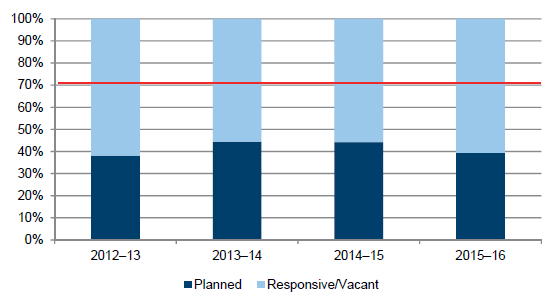
Source: VAGO.
The lack of planned public housing maintenance does not support an optimal life cycle approach to managing public housing assets and is not cost-efficient.
In 2016, a review of DHHS' management of property maintenance attributed this trend to DHHS' current service delivery model and a lack of incentives for contractors to shift from unplanned to planned maintenance within their contracts. Currently DHHS engages seven contractors who service 22 areas, using a schedule of contract rates.
DHHS advised that it is working toward shifting its current model to a facilities management approach, whereby one contractor services one precinct, with additional incentives to maintain properties to a designated asset standard. However, it has raised concerns about whether the market has the capacity to deliver this type of arrangement.
Implementing the annual capital plans
Appendix E details how DHHS has followed its annual capital plans since 2012–13, with a focus on the targeted number of dwellings in the Director of Housing's portfolio, maintenance expenditure and the targeted number of capital upgrades completed. In summary, this information shows that DHHS:
- exceeded its annual target for total dwellings in the Director of Housing's portfolio since 2012–13 by between 0.3 per cent (263 dwellings) and 1.3 per cent (1071 dwellings)—this is a result of DHHS acquiring more dwellings and disposing of fewer dwellings than planned
- overspent on planned, responsive and vacant maintenance by $52.1 million in 2014–15 and $41.8 million in 2015–16—this result was due to DHHS reclassifying housing portfolio costs that had previously been treated as capital investment, which also indicates that DHHS' maintenance expenditure during 2012–13 and 2013–14 had been under-reported
- underspent on statutory maintenance each year since 2012–13 by between $4 million in 2012–13 and $437 000 in 2015–16
- has consistently met its annual target for the number of capital upgrades completed.
4.3.3 Governance arrangements and performance monitoring
The 2012 audit reported that: 'The division does not assess or monitor its asset management strategies. Other than reference to tenant satisfaction surveys, the division does not include performance indicators within its asset management strategies.' It also reported that: 'The performance of a $17.8 billion property portfolio deserves regular and careful monitoring. This lack of evaluation is particularly concerning given the financial pressures within the portfolio, the long lead times needed to create change and the importance of being able to account for the performance of this crucial public service.'
It is important that:
- appropriate governance frameworks be established and clearly communicated to support the management of assets—this includes clarifying communication channels and who is responsible and accountable for all stages of the asset life cycle
- key performance indicators be established to demonstrate the performance of assets
- asset performance be appropriately and continuously monitored to verify that they are achieving required outcomes.
Asset management governance arrangements
DHHS' asset management framework does not specify current roles, responsibilities and accountabilities for the performance and service delivery of public housing assets. Its 2014 asset strategy contains outdated asset management oversight arrangements—a result of numerous changes to its asset management governance structure since the strategy was finalised.
Figure 4F details the DHHS governance committees with a role in managing public housing assets since our 2012 audit.
Figure 4F
DHHS governance committees with a role in asset management
|
Committee |
Role |
Status |
|---|---|---|
|
Capital Committee |
|
Active since January 2013 |
|
Housing Capital Subcommittee |
|
Active from October 2013 to February 2016 |
|
Director of Housing Advisory Committee |
|
Committed to in the 2014 asset strategy but did not eventuate due to machinery-of-government changes |
|
Divisional (regional) Capital Advisory Committees |
|
Active since 2014 |
Source: VAGO.
Since our 2012 audit, DHHS' governance arrangements for managing public housing assets have been inconsistent and affected by machinery-of-government changes, as well as changes to the department's internal structure:
- There have been frequent reviews of the Capital Committee's structure and terms of reference.
- The Capital Committee opted not to meet between April and June 2015 and September 2015 and June 2016, while DHHS' governance framework was under review. DHHS advised that the Director of Housing and the Secretary of DHHS performed the committee's role and functions during this period.
- The Capital Committee has experienced difficulty—when it has met—in having the required number of attendees to reach a quorum.
- The Housing Capital Subcommittee was disbanded in February 2016, and no dedicated governance arrangements for housing asset management were established in its place.
- DHHS committed to but never established a Director of Housing Advisory Committee because of machinery-of-government changes that took effect on 1 January 2015.
Further governance issues exist at the regional level:
- Minutes from the North and West Division Capital Advisory Committees highlight a lack of communication with the central capital committee. This is consistent with findings outlined in Section 4.6 regarding a lack of regional input into central asset planning decisions.
- There is no evidence to show that the East and South Division Capital Advisory Committees have ever held a meeting.
A number of recent internal reviews identified issues that limit DHHS' ability to oversee its management of public housing assets:
- For large housing project contracts valued between $1 million and $10 million, there is no mechanism for DHHS project managers to report to branch managers on progress, costs and time lines.
- DHHS' asset management system is unable to produce financial reports to analyse the cost of maintenance and repair work.
- DHHS processes payments for repairs and maintenance without first assessing the completeness and quality of work provided by contractors.
- Completed property upgrades are not being reflected in DHHS' asset management system in a timely manner, increasing the risk that the defect liability period will lapse and DHHS may incur additional costs in resolving defects. The review found that one in 12 completed property upgrades had not been updated in DHHS' asset management system.
- Maintenance contractors engaged by DHHS have little incentive to bring properties up to or maintain properties at a particular asset standard. DHHS is working to address this issue by implementing a risk-based compliance testing model for assessing the delivery of responsive and vacated property maintenance.
Performance monitoring
The 2014 asset strategy sets six key performance measures (KPM) for public housing. However:
- the KPMs are not sufficiently measurable or outcome focused
- the KPMs lack detail about who is responsible for their delivery and time lines for their completion
- DHHS has not actively monitored its performance against the KPMs in the strategy or evaluated the strategy more broadly.
The six KPMs are detailed in Appendix E and cover areas such as meeting service demand, reducing the operating deficit and monitoring property condition.
DTF's Investment Management Standard provides a useful approach for developing a performance monitoring framework for asset management that focuses on benefits. The standard focuses on defining:
- the problem to be addressed
- the outcomes and associated benefits that will address the problem
- the KPMs that provide evidence that the benefits are being delivered and the problem is being adequately addressed
- the measures to be used against each KPM
- the current baseline, time lines and target values for each measure
- who is responsible for delivering the benefits
- how the benefits will be tracked and reported.
Appendix F shows an example of how the standard could be used to develop performance measures for the management of public housing assets.
4.3.4 Applying current and forecast demand to asset strategies
Our 2012 audit reported that: 'The division does not adequately forecast service levels in the longer term' and 'Neither of the asset management strategies compares existing stock, broken down by asset type and location, to forecast need over the forward period'.
Asset management strategies should consider both current and forecast demand for service delivery. This encourages a proactive asset management approach and enhances the capacity to meet service delivery needs over the short, medium and long term.
Current demand
DHHS' 2014 asset strategy considers existing public housing demand by:
- reporting demand for different bedroom configurations in each of the four regions
- reporting allocation trends by priority segment on the public housing waiting list
- summarising family violence reporting to Victoria Police in each region.
While these types of information provide a useful picture of existing public housing demand, the outdated nature of the 2014 asset strategy undermines its relevance and usefulness.
Future demand
Consistent with the findings of our 2012 audit, DHHS' 2014 asset strategy does not effectively compare its existing stock to future demands in the medium to long term.
There is minimal information in the strategy showing future public housing demand. The strategy does briefly summarise future demand modelling performed for the department in 2013—discussed in Part 2—but there is no evidence showing how this modelling has been applied to the rest of the strategy.
The need for a new demand modelling framework
DHHS currently does not have a dedicated framework for modelling current and future public housing demand on a systematic basis. However, recent work commissioned by DHHS to inform its next asset strategy provides a useful foundation for such a framework. The possible elements of this framework are detailed in Figure 4G.
Figure 4G
Possible demand modelling framework for public housing
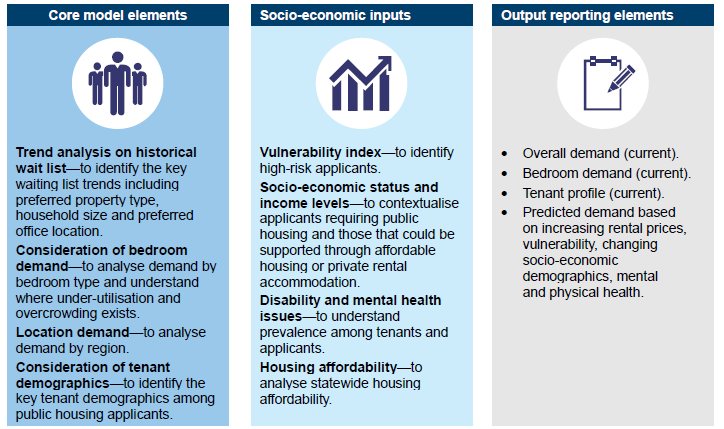
Source: VAGO, based on work commissioned by DHHS.
DHHS is now progressing this work by investigating the current social housing supply and demand landscape across Victoria and at a local level. DHHS expects this work to inform statewide priorities in its next asset strategy.
DHHS' next asset strategy needs to:
- clearly and comprehensively show current public housing demand, as well as future demand over the medium to long term
- compare existing stock and service delivery against forecasted need
- guide priorities, actions and performance measures in the asset strategy
- more effectively advocate for government resourcing to meet public housing service delivery needs.
4.4 Updating and strengthening property condition data
Our 2012 audit reported that: 'Property condition data is poor, preventing a more accurate forecast of accrued maintenance across the portfolio.' It also reported that: 'The division has identified the need to improve its property condition data and, in 2011, developed a service improvement strategy for asset management. The strategy focuses on improving property condition data through a comprehensive audit.'
DHHS needs comprehensive and accurate property condition data to optimise Victoria's $21 billion public housing portfolio—it uses this data alongside a range of other inputs to inform decisions about property upgrades, sales and redevelopments. These other inputs are detailed further in Section 4.3.2.
Property condition data is also important to help DHHS understand and quantify the full extent of public housing maintenance requirements. DHHS advises that it also assesses the maintenance liability of a property immediately before performing any capital works on it.
In this audit, we found that there is a lack of assurance regarding the integrity of property condition data collected across the public housing portfolio during 2013 and 2014. Further, arrangements for property condition assessments that DHHS established in late 2015 have led to significant shortcomings in the timeliness of property condition data.
4.4.1 The 2013–14 comprehensive property condition audit
In line with its previous commitment to improve property condition data, DHHS commissioned a $5.8 million comprehensive property condition audit (PCA) that was completed between January 2013 and October 2014.
DHHS reports that nearly 73 000 out of 76 000 social housing dwellings owned by the Director of Housing were inspected during this PCA. An external contractor performed the vast majority of inspections, with supplementary inspections performed by DHHS' field services officers. There were between 40 and 60 inspectors performing these inspections over the contract period.
DHHS expected the PCA to improve the accuracy, reliability and currency of property condition data across the portfolio. However, there is a lack of evidence showing the extent to which this occurred. This is because:
- the key performance indicators (KPI) included in the contract lacked detail and had little focus on data quality
- although monthly reports from the contractor showed progress made towards completing the inspection program, there was no formal evaluation after the PCA to realise intended benefits and identify areas for improvement.
4.4.2 Ongoing property condition audits
In late 2015, DHHS conducted a competitive tender process to appoint a contractor to perform ongoing PCAs. This process resulted in DHHS engaging the same contractor that had conducted the initial comprehensive PCA for an initial contract term of two years—at an estimated contract cost of $6.8 million—to undertake:
- further PCAs covering 14 000 properties each year
- maintenance compliance assessments (MCA), which evaluate the delivery of responsive and vacant unit maintenance performed by other contactors.
The service delivery KPIs under this contract are more prescriptive than the previous contract. These represent a much clearer and higher level of service for volume of work to be completed, timeliness and quality of service delivery.
However, from the commencement of this contract, the contractor was unable to meet these KPIs. Records of DHHS' meetings with the contractor highlight that only 980 PCAs had been successfully uploaded by 19 September 2016—well short of the 9 000 expected to be completed by that point.
DHHS terminated the contract in December 2016. It is now establishing new PCA and MCA arrangements.
Ultimately, these failures:
- have had a major detrimental impact on the timeliness of property condition data, which in turn has limited DHHS' understanding of the accrued and forecast maintenance backlog
- raise significant doubts about the reliability of existing property condition data generated through the 2013–14 PCA
- have undermined DHHS' ability to make informed, evidence-based asset management decisions.
The absence of up-to-date property condition data emphasises the need for DHHS' asset planning decisions to be sufficiently informed by local knowledge of public housing stock, risks and opportunities.
4.4.3 Currency of property condition data
DHHS has previously committed to assessing the condition of each public housing property every three years. However, this changed under DHHS' 2015 PCA contract.
Figure 4H shows when Victoria's public housing dwellings were last inspected. Specifically, it shows that
- 2 per cent of dwellings were assessed between January and November 2016—the period since the ongoing PCA contract started
- 86 per cent of dwellings had last been assessed during 2013 or 2014—the period that a comprehensive a PCA was completed
- 9 per cent of dwellings had last been assessed between 2006 and 2012—outside of the three-year assessment window previously set
- 3 per cent of dwellings had no record of when they were last assessed.
Figure 4H
Most recent year of inspection for all public housing dwellings
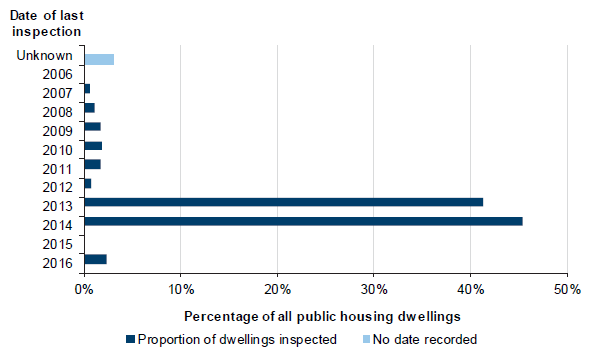
Note: Excludes non-dwelling assets within the public housing portfolio.
Source: VAGO, based on data from DHHS.
4.5 Capturing local knowledge
Our 2012 audit reported that: 'Regional input into asset planning is not consistently captured, meaning local knowledge is not always leveraged.' It also reported that: 'The division's central office recognises the need to improve interaction with, and consistency in, asset management within regions to better capture local knowledge and increase regional participation in asset management.'
Since our 2012 audit, DHHS has continued to follow a centralised approach to asset planning, and the issues previously identified regarding inconsistent regional input have continued. However, DHHS has demonstrated recent efforts to improve how it communicates with and seeks input from regional staff about asset planning.
In September 2016, DHHS' central office surveyed regional staff on what asset management information it should be communicating, where this information should be targeted and how frequently it should be provided. This followed complaints from regional staff about a lack of communication with the central office.
The survey results highlighted:
- a lack of communication with, and feedback sought from, regional staff on asset management programs, with particular concern about redevelopments, acquisitions and handovers of new developments from central office
- unclear decision-making arrangements for regional requests, particularly for acquisitions and disposals.
These issues were also raised during our consultation with regional staff—two of the four regions that we consulted raised specific concerns about a lack of input to centralised asset-planning decisions. One region gave an example where it was not informed about the central office's decision to sell some vacant land in the region until it was contacted by a local real estate agent appointed to process the sale. The region had identified the vacant land as a future redevelopment opportunity.
Figure 4I shows recent DHHS initiatives that aim to improve regional engagement.
Figure 4I
Recent DHHS initiatives to capture regional input for asset planning
|
Initiative |
Description |
|---|---|
|
Divisional (regional) asset plans |
Commencing in May 2016, this initiative aims to develop online asset plans at the regional level that:
To date DHHS has developed an area-based plan for the Central Highlands region. |
|
Asset planning dashboard |
This online tool launched in August 2016 extracts data from DHHS' asset management system to give central and regional staff clearer visibility of:
|
|
Regional workshops |
In February 2016, DHHS' central office ran workshops with each region to help inform the development of its asset upgrade program. |
|
Statewide asset strategy development |
DHHS advised that, as part of its current work to develop an updated asset strategy, its central office has developed detailed demand and supply discussion papers for each local area. This has been supported by discussions with regional staff to share the results of the analysis and identify any factors which may not already be considered. As discussed in Section 4.4.4, this work aims to inform statewide asset priorities, which will form part of the updated asset strategy. |
Source: VAGO.
4.6 Complying with the Asset Management Accountability Framework
From 2017–18 onwards, public sector bodies are required to attest in their annual report that they have complied with AMAF's mandatory requirements. The asset management shortcomings identified in this Part mean that DHHS is currently not in a position to do this.
AMAF requirements that DHHS needs to focus on addressing include, but are not limited to:
- establishing performance standards and targets for assets
- establishing and maintaining management processes to regularly record, monitor and assess asset performance, and use those results to improve performance
- establishing systems and processes to monitor the performance of the asset management system
- developing an asset strategy for the entire asset base over the whole asset life cycle
- having an asset management information system that maintains up-to-date asset information as well as a record of both financial and non-financial information over each asset's life cycle.
Appendix A. Audit Act 1994 section 16—submissions and comments
We have consulted with the Department of Health and Human Services, the Department of Premier and Cabinet and the Department of Treasury and Finance, and we considered their views when reaching our audit conclusions. As required by section 16(3) of the Audit Act 1994, we gave a draft copy of this report, or relevant extracts, to those agencies and asked for their submissions and comments.
Responsibility for the accuracy, fairness and balance of those comments rests solely with the agency head.
Responses were received as follows:
- Department of Health and Human Services
- Department of Premier and Cabinet
- Consolidated action plan provided by the Department of Health and Human Services, the Department of Premier and Cabinet and the Department of Treasury and Finance
RESPONSE provided by the Secretary, Department of Health and Human Services


RESPONSE provided by the Secretary, Department of Premier and Cabinet
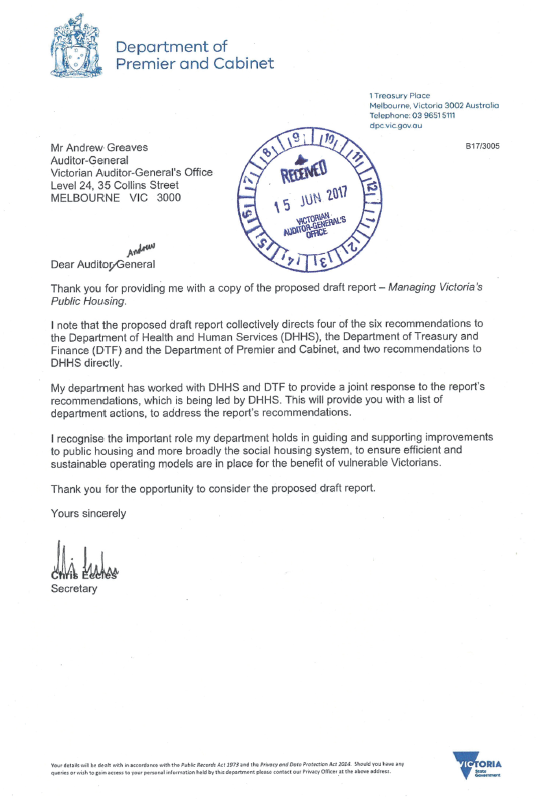
Consolidated action plan provided by the Department of Health and Human Services, the Department of Premier and Cabinet and the Department of Treasury and Finance





Appendix C. Asset strategy priorities
Figure C1 shows the public housing priorities set in the Department of Health and Human Services' (DHHS) 2014 asset management strategy.
Figure C1
2014 asset management strategy priorities
|
Driver |
Priority |
|---|---|
|
Demand |
|
|
Condition |
|
|
Financial |
|
|
Social |
|
(a) PCR10 represents the estimated maintenance and repair liability cost of the asset over a 10-year period
Source: VAGO, based on information from DHHS.
Appendix D. Features of asset life cycle implementation plans
Figure D1 details the expected features of asset life cycle plans based on the Cooperative Research Centre for Infrastructure and Engineering Asset Management's Integrated Strategic Asset Management for Experts.
Figure D1
Features of asset life cycle plans
|
Plan |
Description | |
|---|---|---|
|
Acquisition plan |
Details the assets to be acquired or replaced in the planning period, and establishing acquisition funding sources and costs. The acquisition plan typically includes: | |
|
| |
|
Operations plan |
Defines the use of existing assets, including but not limited to access, security, accountability and performance monitoring. The operations plan typically includes: | |
|
| |
|
Maintenance plan |
Details which assets are to be maintained, the level of maintenance and their delivery. The maintenance plan typically includes: | |
|
| |
|
Disposal plan |
Identifies assets to be disposed of during the planning period, the expected proceeds on disposal and their application. The disposal plan typically includes: | |
|
| |
Source: VAGO, adapted from the Cooperative Research Centre for Infrastructure and Engineering Asset Management's Integrated Strategic Asset Management for Experts.
Appendix E. Delivery of annual capital plans
This Appendix examines how the Department of Health and Human Services' (DHHS) annual capital plans for social housing have been implemented by comparing:
- targeted and actual total social housing dwellings owned by the Director of Housing, factoring in asset acquisitions and disposals
- budgeted and actual expenditure on maintenance
- targeted and actual numbers of capital upgrades.
Targeted number of social housing dwellings
As shown in Figure E1, DHHS has consistently exceeded its targeted number of social housing dwellings since 2012–13. This is as a result of the department acquiring more dwellings than planned and disposing of fewer dwellings than planned.
Figure E1
Targeted and actual social housing dwellings— Director of Housing owned
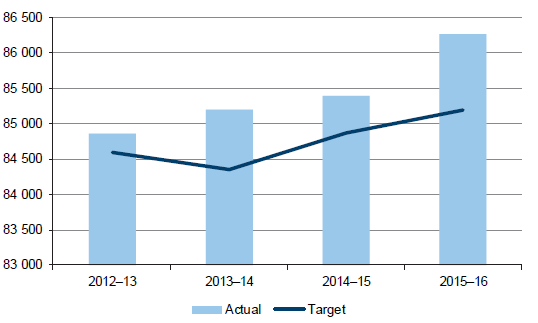
Source: VAGO, based on data from DHHS.
Maintenance expenditure versus budgets
Figures E2 and E3 show that DHHS' maintenance expenditure increased significantly in 2014–15 and exceeded budgeted amounts in both 2014–15 and 2015–16. This was due to DHHS reclassifying housing portfolio costs that had previously been treated as capital investment.
Figure E2
Budgeted and actual expenditure on responsive and vacated maintenance—Director of Housing owned social housing
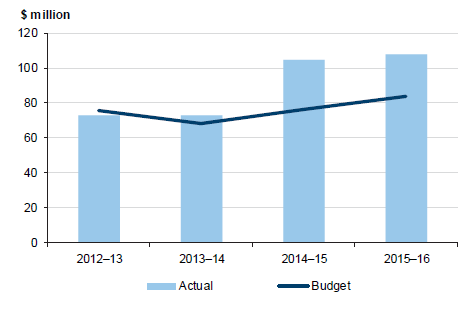
Source: VAGO, based on data from DHHS.
Figure E3
Budgeted and actual expenditure on planned/programmed maintenance—Director of Housing owned social housing
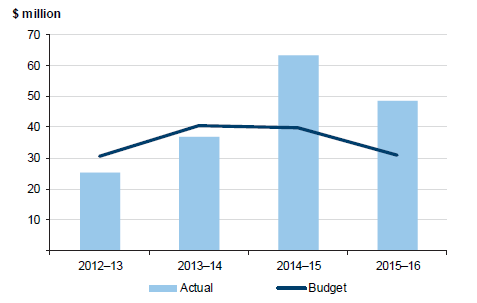
Source: VAGO, based on data from DHHS.
Figure E4 shows that DHHS' expenditure on statutory maintenance has consistently been less than budgeted. The margin of underspend has ranged from $4 million in 2012–13 to $437 000 in 2015–16.
Figure E4
Budgeted and actual expenditure on statutory maintenance—Director of Housing owned social housing
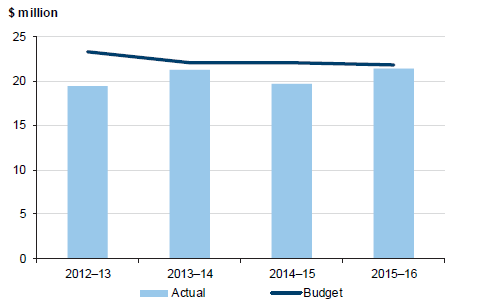
Source: VAGO, based on data from DHHS.
Capital upgrades
Figure E5 shows that DHHS has consistently met its targeted number of capital upgrades since 2012–13.
Figure E5
Targeted and actual number of capital upgrades— Director of Housing owned social housing
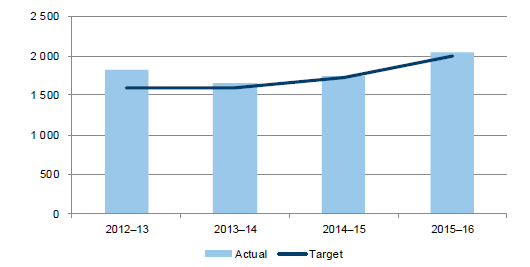
Source: VAGO, based on data from DHHS.
Appendix F. Example performance measures for public housing assets
Figure F1 details 2014 asset management strategy's key performance measures for public housing.
Figure F1
Asset management strategy key performance measures for public housing
|
Key performance measures (KPM) |
Description |
|
|---|---|---|
|
KPM 1 |
Service demand: Improve alignment between supply and demand |
|
|
KPM 2 |
Operating Deficit: Reduce operating costs toward a sustainable benchmark(a) |
|
|
KPM 3 |
Return on Equity: Leverage equity to maximise provisioning outcomes |
|
|
KPM 4 |
Social and Service Outcomes: Deliver improvements to clients |
|
|
KPM 5 |
Monitor property condition: Audit 3 yearly |
|
|
Family violence key performance indicators (KPI) |
Short term (1–2 years):
Medium term (3–5 years):
|
|
(a) KPM was still 'to be confirmed' at the time the strategy was finalised.
Source: VAGO.
Figure F2 shows an example of how the Department of Treasury and Finance's Investment Management Standard could be applied to develop a performance measures for public housing asset management.
Figure F2
Example performance measures for public housing asset management
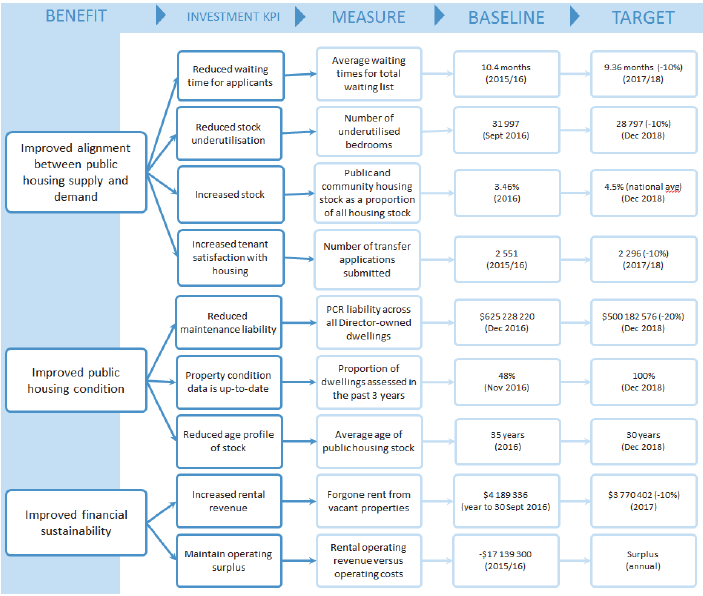
Note: Targets are estimates only and would need to be set by DHHS.
Source: VAGO, based on the Department of Treasury and Finance's Investment Management Standard.
